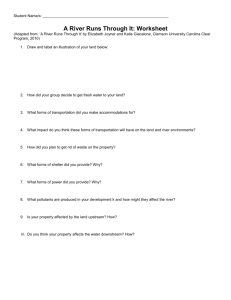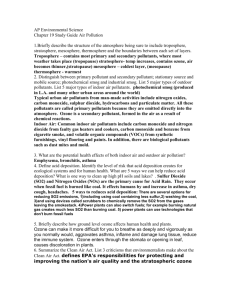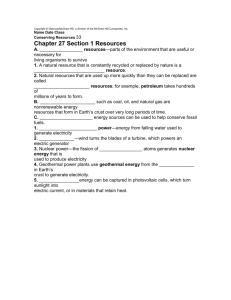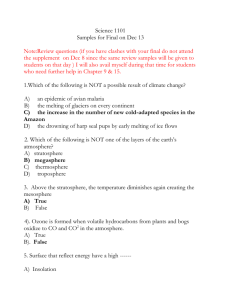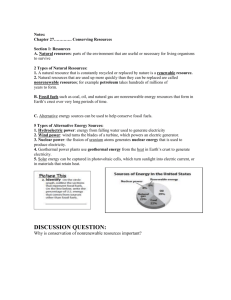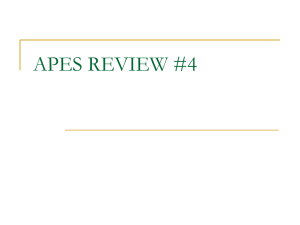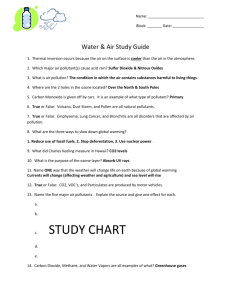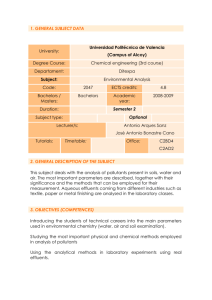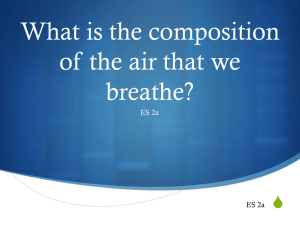Exam 2 Review - University of San Diego Home Pages
advertisement
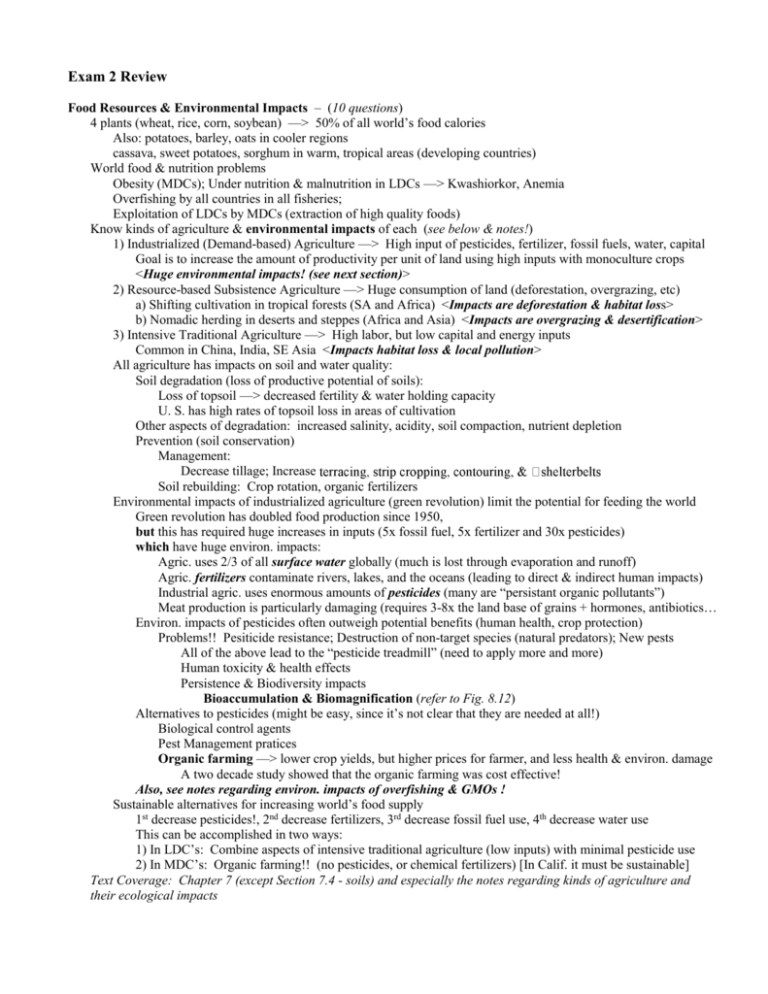
Exam 2 Review Food Resources & Environmental Impacts – (10 questions) 4 plants (wheat, rice, corn, soybean) —> 50% of all world’s food calories Also: potatoes, barley, oats in cooler regions cassava, sweet potatoes, sorghum in warm, tropical areas (developing countries) World food & nutrition problems Obesity (MDCs); Under nutrition & malnutrition in LDCs —> Kwashiorkor, Anemia Overfishing by all countries in all fisheries; Exploitation of LDCs by MDCs (extraction of high quality foods) Know kinds of agriculture & environmental impacts of each (see below & notes!) 1) Industrialized (Demand-based) Agriculture —> High input of pesticides, fertilizer, fossil fuels, water, capital Goal is to increase the amount of productivity per unit of land using high inputs with monoculture crops <Huge environmental impacts! (see next section)> 2) Resource-based Subsistence Agriculture —> Huge consumption of land (deforestation, overgrazing, etc) a) Shifting cultivation in tropical forests (SA and Africa) <Impacts are deforestation & habitat loss> b) Nomadic herding in deserts and steppes (Africa and Asia) <Impacts are overgrazing & desertification> 3) Intensive Traditional Agriculture —> High labor, but low capital and energy inputs Common in China, India, SE Asia <Impacts habitat loss & local pollution> All agriculture has impacts on soil and water quality: Soil degradation (loss of productive potential of soils): Loss of topsoil —> decreased fertility & water holding capacity U. S. has high rates of topsoil loss in areas of cultivation Other aspects of degradation: increased salinity, acidity, soil compaction, nutrient depletion Prevention (soil conservation) Management: Decrease tillage; Increase Soil rebuilding: Crop rotation, organic fertilizers Environmental impacts of industrialized agriculture (green revolution) limit the potential for feeding the world Green revolution has doubled food production since 1950, but this has required huge increases in inputs (5x fossil fuel, 5x fertilizer and 30x pesticides) which have huge environ. impacts: Agric. uses 2/3 of all surface water globally (much is lost through evaporation and runoff) Agric. fertilizers contaminate rivers, lakes, and the oceans (leading to direct & indirect human impacts) Industrial agric. uses enormous amounts of pesticides (many are “persistant organic pollutants”) Meat production is particularly damaging (requires 3-8x the land base of grains + hormones, antibiotics… Environ. impacts of pesticides often outweigh potential benefits (human health, crop protection) Problems!! Pesiticide resistance; Destruction of non-target species (natural predators); New pests All of the above lead to the “pesticide treadmill” (need to apply more and more) Human toxicity & health effects Persistence & Biodiversity impacts Bioaccumulation & Biomagnification (refer to Fig. 8.12) Alternatives to pesticides (might be easy, since it’s not clear that they are needed at all!) Biological control agents Pest Management pratices Organic farming —> lower crop yields, but higher prices for farmer, and less health & environ. damage A two decade study showed that the organic farming was cost effective! Also, see notes regarding environ. impacts of overfishing & GMOs ! Sustainable alternatives for increasing world’s food supply 1st decrease pesticides!, 2nd decrease fertilizers, 3rd decrease fossil fuel use, 4th decrease water use This can be accomplished in two ways: 1) In LDC’s: Combine aspects of intensive traditional agriculture (low inputs) with minimal pesticide use 2) In MDC’s: Organic farming!! (no pesticides, or chemical fertilizers) [In Calif. it must be sustainable] Text Coverage: Chapter 7 (except Section 7.4 - soils) and especially the notes regarding kinds of agriculture and their ecological impacts Environmental Health & Toxicology – (6 questions) Risk = The possibility of suffering harm from a hazard Hazard = An environmental factor that may cause harm or death to an organism Causes injury or disease (morbidity, mortality) 4 Kinds of Hazards: Biological (pathogens: bacteria, fungi, viruses; emergent diseases) Chemical toxins (organic and inorganic chemical poisons) Physical (weather, radiation) Cultural (workplace, driving, smoking, diet) Global disease burdens are changing (Table 8.1, top 3) Communicable diseases are declining, while chronic diseases (e.g., cardiovascular disease) are increasing But, there are new infectious diseases (emergent diseases) in both humans and animal populations And a growing resistance of bacteria to antibiotics (mostly b/c of overuse Lack of money for disease prevention and health care Toxicology – Measure of harmfulness of a toxic substances (poisons) Know categories of affects of chemical toxins: (allergens, mutagens, teratogens, carcinogens, neurotoxins, hormone disrupters) Movement and distribution of toxins (water soluble vs. fat soluble) Exposure and susceptibility Persistence Bioaccumulation Biomagnification (Fig. 8.12!) Responses to toxicity depends on pathway & dose (see notes) Risk assessment Be able to describe the progression of risk assessment leading to risk management (Fig. 8.18) Text Coverage: Chapter 8 (Sections 8.1, 8.2, 8.3, & 8.6) and especially notes Atmosphere, Climate Change, and Global Warming (8 =10 questions) Layers of the atmosphere & approx. heights (Fig. 9.3) Troposphere / Stratosphere / Mesosphere / Thermosphere Chemical constituents of atmosphere (troposphere) N2 (78%), O2 (21%), Ar, CO2, water vapor Ozone layer is in stratosphere Earth’s Energy Budget and Climate (Fig. 9.5) Greenhouse gases & Global warming (Read Case Study, p 206) Know Greenhouse gases: CO2 (60%), CH4 (20%), CFC's (10%), N2O (5%); also includes water vapor Greenhouse gases —> Atmospheric warming Predicting effects of greenhouse gases: Requires understanding effects of climate variation and long-term climate change (Fig. 9.8 9.9 & p216-17) Positive and Negative feedbacks complicate studying Earth's climate Global warming will change temperature & rainfall patterns, ice caps, and sea levels These physical changes will affect plant life, animal life, ecosystems, and human populations! Oceans will be vulnerable to temperature and acidification! Evidence of global warming and its effects are extensive (p 218) Strategies for dealing with greenhouse gases (solutions vs. adaptations) Meeting the Kyoto Protocol with various social and technological methods (Section 9.4) Text Coverage: Chapter 9 (Sections 9.1–9.4) Air Pollution – (8 questions) Definitions, sources, types Primary pollutants – Released directly into the air (CO, NOx, SO2, volatile hydrocarbons, particulates, lead) These plus ozone (O3) are referred to as “Conventional Pollutants” by EPA (greatest amounts & concern) “Unconventional Pollutants” include other potentially harmful compounds that are mostly primary pollutants Secondary pollutants – Created by chemical reactions in the atmosphere (accelerated by, or involve UV light) Photochemical oxidants (smog & haze) = NO2 + O3 + PAN (see Table 9.3) Know sources and impacts of conventional pollutants (p 219 & notes) Effects of air pollution (pp 232-233) Health effects; damage to plants and forests Acid formation and deposition (HNO3, H2SO4) (know primary pollutants that lead to acid formation) Direct effects - foliage damage, soil microbial damage, leaching of nutrients SO2, O3, & acids —> Damage and kill plants, corrode metals and erode stone, cause cracking and brittleness in plastics and rubber Prevention [most important] and Cleanup Clean Air Acts of 1963, 1970, 1977 Establishes regulations & controls for “conventional” pollutants (CO, NOx, SO2, VOC [hydrocarbons], particulates, ozone, lead) Additional laws further reduce pollutants —> acid rain, urban smog, CFCs Cap & trade program worked to lower SO2 levels Between 1970 – 2006: CO, SO2, VOC decreased by 50%; lead decreased by 98% But Particulates &NOx have only declined by about 30% & 15%, respectively Bush Administration weakened or attempted to weaken existing laws from 2001 to 2008 Ozone depletion in stratosphere Formation of O3 (ozone) by UV light (see Table 9.4) O3 destroyed by Chlorine (from chlorofluorocarbons that rise up into the lower stratosphere) Loss greatest at poles (about 50% reduction in most years - more in some) Potential impacts of decreased stratospheric ozone are increased damaging UV radiation at the Earth’s surface (There is no relationship between UV radiation & global warming!) Text Coverage: Chapter 9 Sections 9.5 & 9.7)
